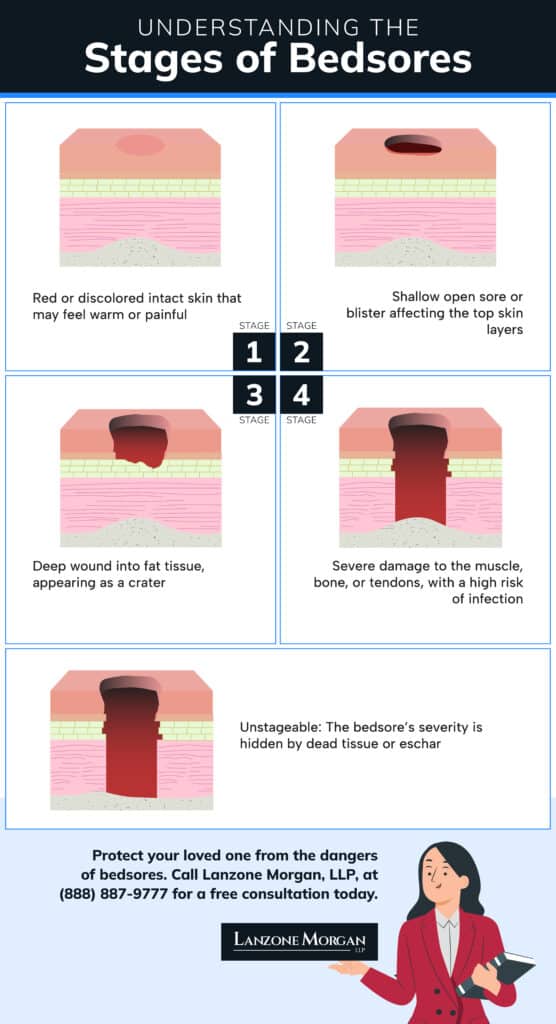Stages of Bedsores

- Reviewed By
Anthony C. Lanzone, Founding Partner
- When nursing homes and care facilities ignore their basic responsibilities to keep residents clean, comfortable, and safe, it puts the residents at risk of painful and potentially life-threatening wounds.
- Bedsores, also called pressure ulcers, range from mild redness to severe tissue damage, exposing bone, and are categorized into four stages.
- If you or someone you love has developed pressure ulcers, it could indicate nursing home neglect.
- Learn about the stages of bedsores and how Lanzone Morgan, LLP’s bedsore attorneys in California can help your family seek justice.
Bedsores are injuries to the skin and underlying tissue caused by prolonged pressure. They most commonly develop in nursing home residents who are immobile or neglected. The severity of a bedsore is classified into stages, with higher stages indicating deeper, more dangerous wounds. These stages not only determine medical treatment but may also reveal neglect or abuse by nursing home staff.
If your loved one is suffering from a bedsore, our team at Lanzone Morgan, LLP, can help. Call us at (888) 887-9777 for a free consultation to protect their rights and well-being.
Table of Contents:
- Understanding Bedsores and Their Dangers
- The 4 Stages of Bedsores
- How are Bedsores Diagnosed
- How to Spot the Warning Signs of Bedsores in Your Loved One
- Common Causes of Bedsores in Nursing Homes
- Who’s Responsible for What Happened to Your Loved One?
- How We Help Families Fight Back Against Nursing Home Neglect
- Our Bedsore Attorneys Get Results
- Take the First Step Toward Justice and File Your Nursing Home Abuse Claim
Understanding Bedsores and Their Dangers
Bedsores, also known as pressure ulcers or pressure sores, are injuries caused by prolonged pressure on the skin. They often develop on bony areas such as the tailbone, heels, hips, or back. In nursing homes, bedsores can indicate inadequate care, poor monitoring, or neglect.
According to a 2004 report by the Centers for Disease Control and Prevention, about 11% of nursing home residents suffer from pressure ulcers each year. Advanced-stage bedsores are not just painful injuries; they are often a medical emergency and can become life-threatening if untreated.
The 4 Stages of Bedsores
Bedsores progress through four stages, from mild skin discoloration to deep wounds affecting muscles, tendons, or bones. Recognizing these stages is crucial for treatment and assessing potential legal liability if the facility failed to provide necessary care and services.
Stage 1 Bedsore: Reddened Skin
Stage 1 bedsores appear as persistent redness or discoloration on intact skin. The area may feel warm, firm, or painful. At this stage, the damage is superficial. However, if not addressed quickly, they can progress to deeper injuries.
Stage 2 Bedsore: Partial-Thickness Skin Loss
Stage 2 pressure injuries involve partial-thickness loss of skin, affecting the top layer, the epidermis, and sometimes the second layer, the dermis. The area may appear as an open, shallow sore with a red or pink wound bed, or as a blister.
Stage 3 Bedsore: Full-Thickness Skin Loss
Stage 3 pressure injuries involve full-thickness skin loss extending into the subcutaneous tissue, or fat layer, beneath the skin. The sore may appear as a deep crater, and there is a high risk of infection at this stage.
Stage 4 Bedsore: Severe Tissue Damage
Stage 4 bedsores are the most severe, involving extensive damage to skin, muscle, bone, and supporting structures such as tendons or joints. These injuries can lead to life-threatening infections like sepsis and require urgent medical intervention.
Unstageable
An unstageable bedsore is covered by dead tissue or dark, scab-like tissue, making it impossible to determine its depth until the dead tissue is removed.

How are Bedsores Diagnosed
Health care providers diagnose bedsores through physical examinations, assessing the appearance, depth, and condition of the wound. In severe cases, they may also use imaging to check for bone damage.
The timing of a diagnosis can significantly impact legal timelines, as early documentation is important when pursuing a claim. Lanzone Morgan, LLP uses detailed medical records, care notes, and facility logs to build strong cases that hold nursing homes accountable for neglect.
Common Causes of Bedsores in Nursing Homes
Bedsores are rarely just an unfortunate side effect of aging. They usually stem from serious lapses in care.
Bedsores often result from the following:
- Failure to reposition immobile residents
- Lack of proper hygiene or moisture management
- Poor nutrition and hydration
- Understaffing or inadequate training
- Ignoring risk assessments or care plans
These failures are preventable with attentive care. Unfortunately, bedsores often arise from systemic issues in nursing homes, such as understaffing and profit-driven neglect.
How to Spot the Warning Signs of Bedsores in Your Loved One
Family members should watch for early warning signs, including:
- Redness or discoloration on bony areas
- Warmth, firmness, or sponginess in the skin
- Complaints of pain in a specific area
- Blisters, open wounds, or drainage
- Foul odor from the wound site
Detecting these signs early can prevent serious complications and help identify neglect before it escalates.
“And one of the main defenses in all of our cases is whatever happened to this person wasn't because of neglect. What happened to this person was because of their underlying disease processes, their age. This was just inevitable. That's not true. People aren't supposed to get bed sores. Especially when the family's trying to do the right thing by entrusting the care and paying thousands of dollars so that this doesn't happen because they don't have the expertise to take care of them and keep them safe themselves.”
Anthony Lanzone, Founding Partner
Who’s Responsible for What Happened to Your Loved One?
While not every bedsore results from abuse, repeated or advanced-stage bedsores often indicate neglect. Nursing homes, assisted living facilities, hospitals, and staff may all be liable. Lanzone Morgan, LLP, has built a reputation for successfully holding nursing home corporations accountable and fighting for families across California.
Take the First Step Toward Justice and File Your Nursing Home Abuse Claim
If your loved one has suffered from bedsores in a nursing home or care facility, Lanzone Morgan, LLP, can help. Contact our skilled bedsore attorneys today for a free consultation. Call us anytime at (888) 887-9777 or fill out our contact form to begin your path to justice.

- Fact-Checked
This content has been legally reviewed and approved by nursing home abuse attorney, Anthony Lanzone. Anthony holds notable memberships with professional organizations including the American Association for Justice and Consumer Attorneys of California.
VIEW SOURCES
Chen, Z., Gleason, L. J., & Sanghavi, P. (2022, October). Accuracy of pressure ulcer events in US nursing home ratings : Medical care. Medical Care: Official Journal of the Medical Care Section, American Public Health Association.
https://journals.lww.com/lww-medicalcare/Fulltext/2022/10000/Accuracy_of_Pressure_Ulcer_Events_in_US_Nursing.7.aspx
Park-Lee, E., & Caffrey, C. (2009, February). Pressure Ulcers Among Nursing Home Residents: United States, 2004. Centers for Disease Control and Prevention.
https://www.cdc.gov/nchs/products/databriefs/db14.htm
Smith, D. M. (1995, September 15). Pressure ulcers in the nursing home. PubMed.
https://pubmed.ncbi.nlm.nih.gov/7639444/
Voss, A. C., Bender, S. A., Ferguson, M. L., Sauer, A. C., Bennett, R. G., & Hahn, P. W. (2005, September). Long-term care liability for pressure ulcers. Journal of the American Geriatrics Society. https://pubmed.ncbi.nlm.nih.gov/16137292/

- Fact-Checked
This content has been legally reviewed and approved by nursing home abuse attorney, Anthony Lanzone. Anthony holds notable memberships with professional organizations including the American Association for Justice and Consumer Attorneys of California.
VIEW SOURCES
Chen, Z., Gleason, L. J., & Sanghavi, P. (2022, October). Accuracy of pressure ulcer events in US nursing home ratings : Medical care. Medical Care: Official Journal of the Medical Care Section, American Public Health Association.
https://journals.lww.com/lww-medicalcare/Fulltext/2022/10000/Accuracy_of_Pressure_Ulcer_Events_in_US_Nursing.7.aspx
Park-Lee, E., & Caffrey, C. (2009, February). Pressure Ulcers Among Nursing Home Residents: United States, 2004. Centers for Disease Control and Prevention.
https://www.cdc.gov/nchs/products/databriefs/db14.htm
Smith, D. M. (1995, September 15). Pressure ulcers in the nursing home. PubMed.
https://pubmed.ncbi.nlm.nih.gov/7639444/
Voss, A. C., Bender, S. A., Ferguson, M. L., Sauer, A. C., Bennett, R. G., & Hahn, P. W. (2005, September). Long-term care liability for pressure ulcers. Journal of the American Geriatrics Society. https://pubmed.ncbi.nlm.nih.gov/16137292/
